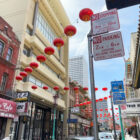After nearly five hours of public debate, the Board of Supervisors halted plans for the development of a 38-story condominium tower Tuesday night.
Many of the project’s opponents were concerned with the possibility that the building would harm surrounding parks — Maritime Plaza, Sue Bierman Park and the privately owned redwood grove at the foot of the Transamerica pyramid. Specifically, they emphasized the impacts of shadows, wind and interrupted bird migration routes.
The board voted 10-0 to overturn the Planning Commission’s certification that the environmental impact report for the building at 555 Washington St. was adequate, accurate and complete. A representative of the developer said it was unlikely the project would proceed because the additional reports required would run the multimillion-dollar bill even higher.
Supervisor Chris Daly said the document was one of the most problematic he has seen in his tenure on the Board of Supervisors. Some three-dozen people came to support an appeal on behalf of San Franciscans for Reasonable Growth and the Telegraph Hill Dwellers, neighborhood groups that mounted an organized effort to defeat the tower plan.
The tower would cast shadows on the two public parks, in conflict with the 1984 Proposition K, which protects sunlight and limits shade in city-owned parks.
Board of Supervisors President David Chiu noted that wind speeds would increase to 39 mph in certain locations, enough to cause difficulty balancing. According to planning codes, developments are not allowed to cause wind speeds to exceed the “hazardous” level of 26 mph.
“It looks pretty clear if you compare the existing current situation with the other three options, that the hazardous situation increases in each of those instances,” Chiu told Bill Wycko, an environmental review officer at the Planning Department.
Wycko noted that those hazards already exist, and that in other cases the increase “is not significant.”
David Turner, an arborist, said the trees in Redwood Park are already stressed, and that the roots of some may extend to the site of the proposed building.
“And beyond the loss of the trees, the greater shadows and elevated winds deflected down on to the park from the proposed building would further stress the remaining trees,” Turner said.
Other opponents of the building worried about increased traffic and the aesthetics of the area. The building would stand almost 200 feet above the height allowance of the rest of that zone. Some in the audience argued that approval of the building would be unfair spot zoning.
“We need to support the appellants,” said Gerry Crowley, an opponent of the project “From childhood, we’re taught to obey the laws. The Board of Supervisors needs to obey the laws of San Francisco.”
A similar number of attendees addressed the board in support of the project. Many noted the economic benefits that a project would bring, such as job opportunities and city revenue. The developers also proposed more than $12 million in affordable housing units.
“We urge you to support the EIR, approve this project, and get it started while we still have someone willing to invest,” said Peter Scott, representing the Jackson Square Historic District. “Let’s create construction jobs, the long-term jobs, and let’s get that $12 million in low-income housing.”
But Supervisor David Campos said the board was meeting to rule not on the project, but on the analysis of environmental impact.
“The reality is that from my public policy standpoint, which is not a consideration for this hearing, it is difficult to vote against a project,” Chiu said. “You want to create jobs. You want workers to be employed. So why was this approached this way?”
While the developers could recirculate the environmental impact report for a revised analysis, they likely will not. The developers have already spent $6 million on the analysis.
“I cannot recommend to my clients that it is worth spending an additional $1 million with no potential avenue for success,” said Andrew Segal, one of the developers. “To be honest, if we have to recirculate the EIR, we are done.”









